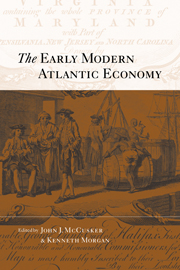Book contents
- Frontmatter
- Contents
- List of figures
- List of tables
- List of abbreviations
- List of contributors
- Dedication
- Introduction
- Part I The role of merchants and their connections
- Part II The development of trades
- Part III Imperial economies
- 9 France, Britain and the economic growth of colonial North America
- 10 Merchants and bankers as patriots or speculators? Foreign commerce and monetary policy in wartime, 1793–1815
- 11 America and the crisis of the British imperial economy,1803–1807
- Part IV Colonial working societies
- Index
9 - France, Britain and the economic growth of colonial North America
from Part III - Imperial economies
Published online by Cambridge University Press: 16 October 2009
- Frontmatter
- Contents
- List of figures
- List of tables
- List of abbreviations
- List of contributors
- Dedication
- Introduction
- Part I The role of merchants and their connections
- Part II The development of trades
- Part III Imperial economies
- 9 France, Britain and the economic growth of colonial North America
- 10 Merchants and bankers as patriots or speculators? Foreign commerce and monetary policy in wartime, 1793–1815
- 11 America and the crisis of the British imperial economy,1803–1807
- Part IV Colonial working societies
- Index
Summary
This chapter will discuss some questions about the comparative settlement patterns and long-term development of the imperial economies of the French and the British in the Americas, and how these related to the differential growth patterns of the European nations. Little will be said, however, about their colonies elsewhere in the eighteenth and nineteenth centuries, including those in Africa and in India, which did not attract large-scale settlements of Europeans, as did the American colonies. In some ways the answers to questions about comparative long-term success are obvious –France lost its largest settlement (Canada) in 1763, and its most prosperous settlement (indeed at that time the world's most prosperous area), Saint-Domingue, after 1791. This loss of Saint-Domingue, and its failure to recover as a sugar producing power after independence, provided a major boost to British colonial power, permitting, among other things, the British to increase sharply their share of Caribbean sugar production. France had sold another of its New World settlements to the United States in 1803, after it had effectively lost control of Louisiana to Spain between 1763 and 1800. France's remaining post-1815 settlements in the Caribbean (which still remain parts of France today) were few in number and smaller in total size compared to the larger number and sizes of the British islands. Britain, on the other hand, had gained colonial possessions from France, including Canada and various islands in the Caribbean, and maintained possession of them for considerable time.
- Type
- Chapter
- Information
- The Early Modern Atlantic Economy , pp. 227 - 249Publisher: Cambridge University PressPrint publication year: 2001
- 1
- Cited by

